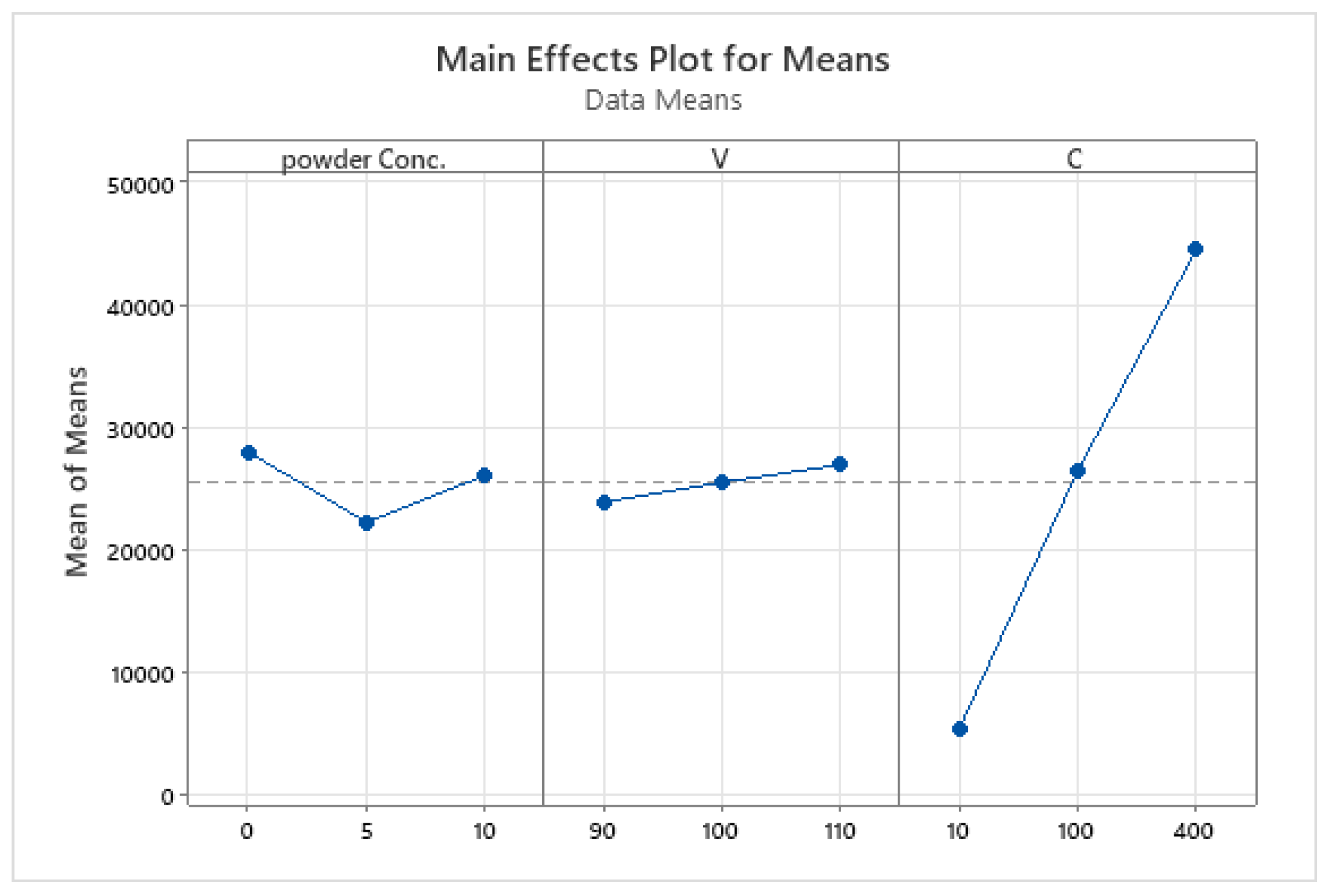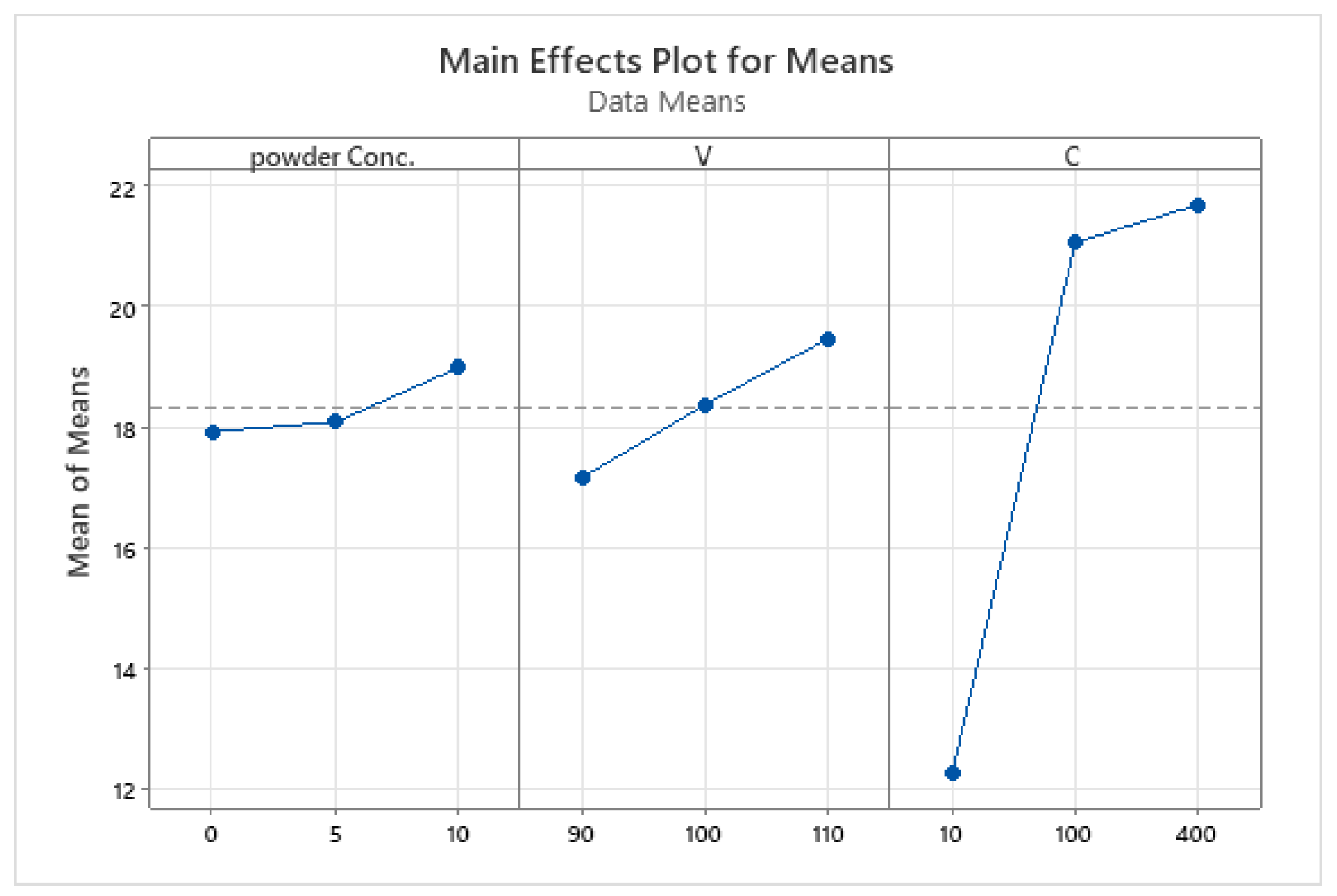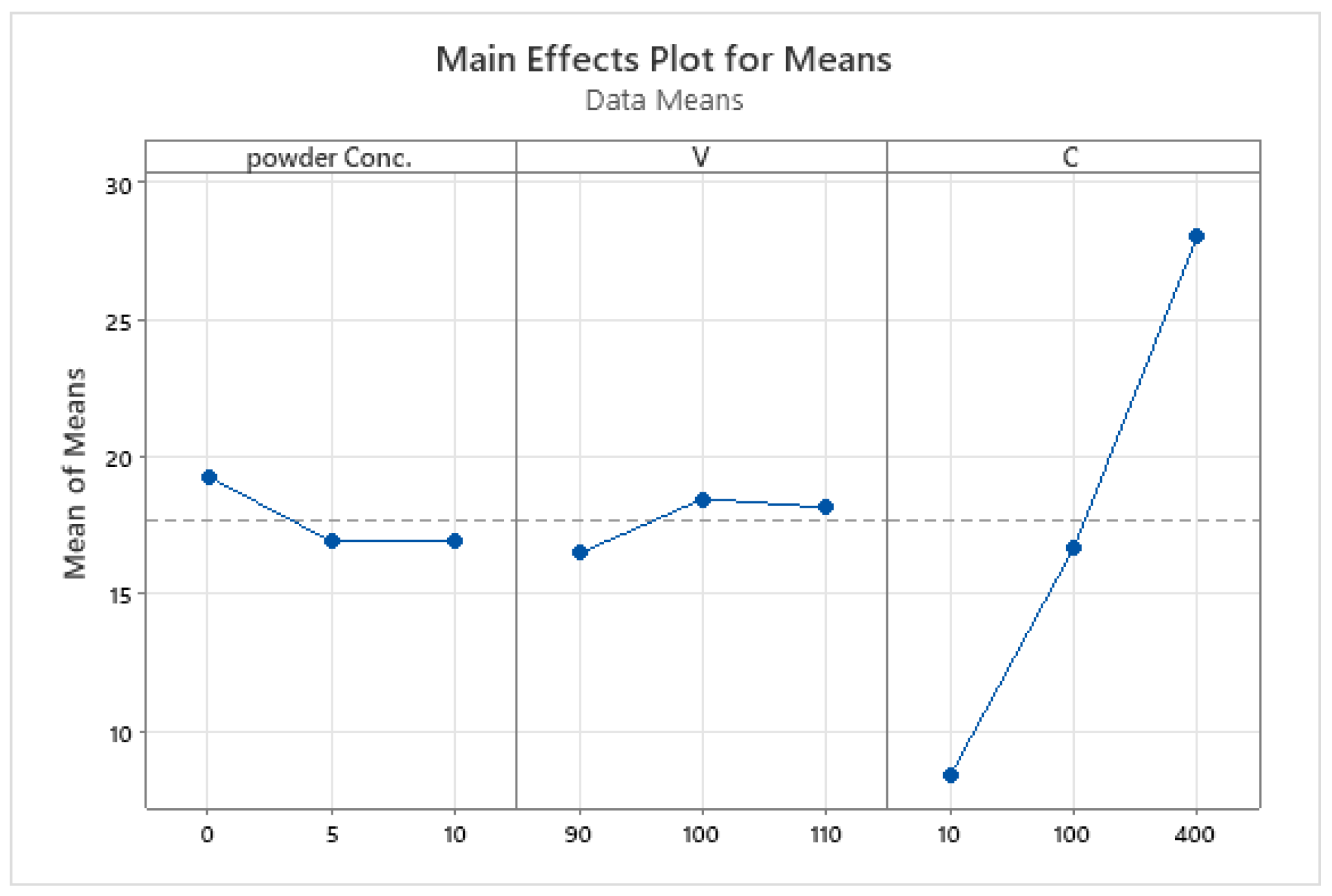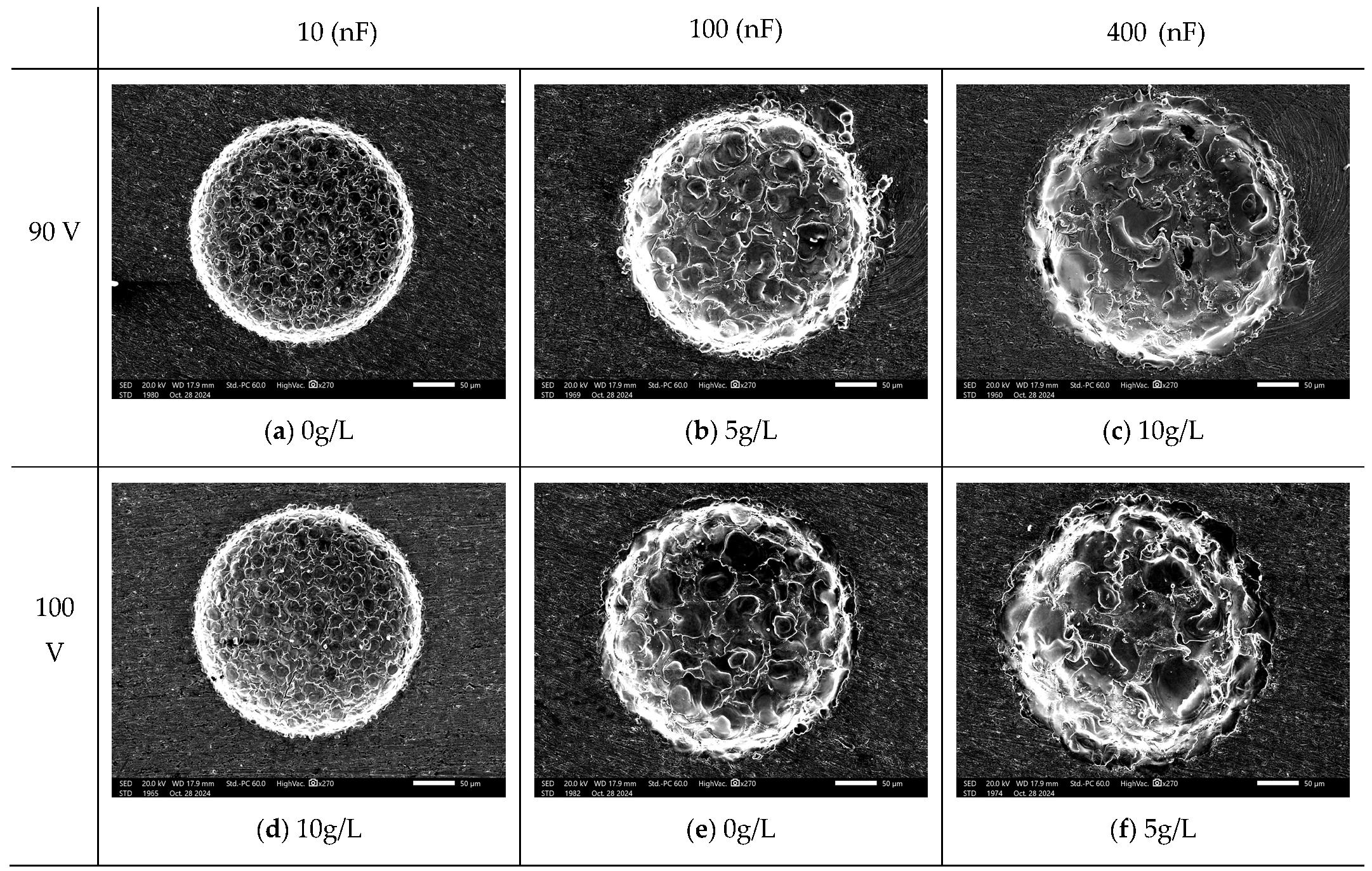1. Introduction
The demand for bone replacement and fixing surgeries is increasing with a high interest in biomedical implants. While the value of biomedical implants was USD 5.7 billion in 2022, it is expected to quadruple to USD 24.8 billion by 2031 [
1]. With this increase in demand, new alloys are developed to enhance physicochemical properties and functional performance. One of the most popular alloys used for biomedical applications is TiAl6V4 [
2]. Even though TiAl6V4 is widely used, it faces several challenges. TiAl6V4 is prone to stress shielding caused by the difference in Young’s moduli of this alloy (110 GPa) and human bones (20–30 GPa). Secondly, aluminum and vanadium are cytotoxic [
3].
To overcome the disadvantages, Ti-35Nb-7Zr-5Ta (TNZT) can be used. TNZT offers a lower elastic modulus, which is up to 81 GPa. Therefore, the elastic modulus of TNZT is closer to human bones than that of TiAl6V4 alloy. Also, TNZT does not consist of any cytotoxic elements, and this is highly favorable for human organisms. In addition to low elastic modulus and the absence of cytotoxic materials, TNZT shows excellent biocompatibility along with high corrosion resistance [
4]. Overall, TNZT alloy is a better candidate than TiAl6V4 for biomedical applications.
Micro-electro-discharge machining (μ-EDM) is a nonconventional machining method to machine hard materials with micro-scale precision. μ-EDM modification of the surface improves tissue integration [
5]. Moreover, the noncontact treatment by μ-EDM reduces the damage and distortion of the workpiece [
6]. Previously, experiments were conducted on titanium alloys by using μ-EDM. The discharge current and the pulse on time significantly impact EDM efficiency [
7]. Numerous investigations were conducted on Ti6Al4V as it is one of the most popular biomedical alloys used in biomedical implants. However, its machinability using μ-EDM remains dearth. Shahid et al. found that increasing capacitance at 80 V voltage enhances material removal rate (MRR), surface roughness, and microhardness, and raising capacitance from 10 to 100 nF increased MRR by a factor of 6.38, surface roughness by 3.29, and microhardness by 1.07 [
8]. However, further increases in capacitance led to diminishing MRR and higher surface roughness due to larger crater formation.
The machinability of Ti-35Nb-7Zr-5Ta alloy by powder-mixed micro electro-discharge machining (PM-μ-EDM) has not been performed yet. The usage of the HA powder in μ-EDM offers superior biocompatibility and osseointegration because HA powder is similar to the crystal structure of human bone. HA powder in the micro-EDM process on Ti6Al4V significantly enhances MRR, size, overcut, and circularity. In this study, the machinability of Ti-35Nb-7Zr-5Ta (TNZT) alloy was investigated using PM-µ-EDM with the HA powder. In this study, the effect of variation in HA powder concentration, gap voltage, and capacitance on material removal rate (MRR), overcut, and circularity was investigated. Additionally, surface composition and structural changes generated by PM-µ-EDM were analyzed using energy-dispersive X-ray spectroscopy (EDS) and scanning electron microscopy (SEM) on machined and unmachined samples.
2. Methodology
2.1. Experimental Setup
In PM-µ-EDM, the HA powder with the chemical composition Ca
5(PO
4)
3(OH) was used at three concentration levels: 0, 5, and 10 g/L. The gap voltage was adjusted to 90, 100, and 110 V. The capacitance was set at 10, 100, and 400 nF. The machining was performed with a tungsten carbide electrode tool of 237 μm diameter, and hydrocarbon oil was used as the dielectric fluid. The machined hole depths were maintained at 50 μm for consistency. These parameters and conditions were selected to observe their individual and combined effects on TNZT’s surface quality and machining performance. Machining was carried out using the MIKROTOOLS DT-110 micro-EDM machine (Mikrotools, Singapore). The machining setup is illustrated in
Figure 1.
2.2. Surface Analysis
After machining, SEM and EDS were used to examine the surfaces. SEM imaging and EDS analysis were conducted with the Scanning Electron Microscope JEOL JSM-IT200 (LA) to capture detailed images of the surface morphology of machined samples and composition on the surface, focusing on calcium and phosphate from HA. Baseline SEM and EDS were used to analyze unmachined TNZT samples and compare with the PM-µ-EDM treated surfaces.
2.3. Design of Experiment (DoE)
The Taguchi method was used for the design of experiments to evaluate multiple parameters efficiently, also reducing the number of experiments needed. An L9 orthogonal array was selected for a structured investigation of the three levels for the HA powder concentration, gap voltage, and capacitance [
9]. The experiment was repeated three times, and the mean values of the result were calculated. The effects of the HA concentration, gap voltage, and capacitance levels on the PM-µ-EDM machining of TNZT alloy were investigated.
3. Results and Discussions
3.1. MRR, Overcut, and Circularity
MRR, overcut, and circularity were significantly affected by input parameters of capacitance, voltage, and HA powder concentration levels. The MRR ranged from 4121.78 to 48,554.99 µm
3/s, overcut from 10.33 to 22.51 µm, and circularity from 7.52 to 30.86 µm, as summarized in
Table 1.
The highest MRR (48,554.99 µm
3/s) and circularity (30.86 µm) were obtained with a capacitance of 400 nF, voltage of 110 V, and 0 g/L of the HA powder (
Figure 2). This combination enabled higher capacitance and higher voltage without any powder added and boosted MRR because discharge energy was stronger. These findings coincide with the results of Shahid et al. [
8] who reported increased capacitance amplified MRR as the spark energy intensified on the surface.
Conversely, the lowest MRR (4121.78 µm
3/s) and circularity (7.52 µm) were observed at 10 nF capacitance, 110 V, and 5 g/L of the HA powder. The lower capacitance reduced discharge energy thereby reducing MRR. The addition of HA powder stabilized the dielectric and limited the MRR, as noted in Ref. [
10]. With higher powder concentrations, MRR experiences reduction due to better gap insulation, while the further addition of the powder (10 g/L) increases the powder concentration in the discharge gap, leading to effective flushing and hence higher MRR [
11,
12,
13].
Figure 3 displays the variation in overcut with process parameters. The overcut values influenced the precision of machined holes, ranging from 10.33 µm to 22.25 µm. The highest overcut was at 400 nF capacitance, 90 V voltage, and 10 g/L of the HA powder, while the lowest overcut was at 10 nF, 90 V, and 0 g/L. These results indicated a direct relationship between increased capacitance which increased discharge energy and overcut due to larger crater formation. Higher discharge energy increases crater size, leading to larger overcut and reduced dimensional accuracy [
14].
Figure 4 illustrates the variation in circularity with process parameters. The circularity of the micro-hole reduces with the increase in capacitance. The higher the capacitance, the higher the discharge energy and the more intense and wider sparks on the surface. This deteriorates the circularity. However, a deviation from the expected relationship was observed for MRR, overcut, and circularity at a specific combination of 10nF capacitance, 110 V voltage and 5g/L HA powder concertation. At these machining settings, the overcut values doubled along with a certain drop in circularity. This anomaly resulted from powder concentration fluctuations in the dielectric gap that caused inconsistent sparking and crater formation. Similar deviations were observed in PM-µ-EDM studies, particularly at low capacitance levels, where dielectric stability was easily disrupted, leading to unexpected increases in overcut [
15].
Overall, higher capacitance generally enhanced MRR, overcut, and circularity due to increased discharge energy, while higher HA powder concentrations stabilized the gap but reduced MRR by dampening thermal energy transmission.
3.2. SEM Analysis
The SEM images (
Figure 5) revealed notable differences in surface morphology and crater size based on capacitance levels. Surfaces machined at 10 nF showed the smallest crater sizes, resulting in smoother morphology at the expense of significantly longer machining times. This aligned with previous findings indicating that lower capacitance settings generally slowed down the machining process due to reduced discharge energy while producing finer surfaces [
10].
The largest craters were observed in surfaces machined at 400 nF because of the higher discharge energy levels generated at this capacitance. As the high energy facilitates rapid material removal, these larger craters compromise surface smoothness for faster machining time. The 100 nF setting showed a balance between these extremes by achieving relatively good surface morphology with moderate crater sizes and a machining time, which was slightly longer than that of the 400 nF setting. This result suggested that 100 nF enables compromise between surface quality and efficiency.
The HA powder concentration and machining time showed an interesting correlation: the machining times for 0 and 10 g/L of HA concentrations were similar, while the 5 g/L of the HA powder considerably lengthened machining times following a parabolic trend. This parabolic relationship was caused by HA particles in the dielectric fluid as a moderate concentration (5 g/L) potentially created an optimal level of insulation within the gap. This slowed the machining process more at higher or lower concentrations than 5 g/L. Moreover, PM-µ-EDM showed similar trends, where certain powder concentrations yielded longer machining times because dielectric has changes in its properties [
10].
These findings demonstrated the trade-offs between surface quality and machining efficiency in PM-µ-EDM. Better surface morphology was achieved with a lower capacitance and moderate powder concentration, spending more machining time. In contrast, higher capacitance and certain powder levels accelerated machining but produced rougher surfaces. These results provide information on how to determine machining parameters for TNZT alloy in biomedical applications, where a balance between precision and efficiency is crucial.
3.3. EDS Analysis
EDS analysis was conducted on the unmachined surface and three machined surfaces with parameter combinations of (0 g/L, 90 V, 10 nF), (5 g/L, 90 V, 100 nF), and (10 g/L, 90 V, 400 nF) to assess elemental changes from the PM-µ-EDM process (
Table 2). There was a notable increase in carbon content, approximately doubling in mass and atomic percentages on the machined surfaces. The use of a tungsten carbide electrode and hydrocarbon oil as the dielectric fluid caused the increase by introducing carbon into the machined surface. Oxygen content, however, decreased significantly post-machining in all samples but remained higher than those with 5 and 10 g/L of the HA powder as HA inherently contains oxygen atoms. This observation aligned with findings in PM-µ-EDM research where the addition of oxygen-bearing powders in the dielectric influenced surface composition.
The presence of tungsten from the electrode remains consistent across all machined surfaces, while the concentrations of zirconium and niobium show no significant changes and stay within the initial range, indicating the stability of these elements during machining. The addition of the HA powder of 5 and 10 g/L introduced trace amounts of calcium and phosphorus to the surface, which attributed to HA’s composition.
An interesting observation was noted in the behavior of titanium and tantalum. The unmachined and 10 g/L machined surfaces showed similar levels of titanium and tantalum, while the machined surfaces with 0 and 5 g/L of the HA powder exhibited a decrease in titanium and a corresponding increase in tantalum.
These findings underscore the impact of HA powder concentration and machining parameters on elemental retention and surface composition. The HA powder helps maintain oxygen levels and reduces titanium loss at higher concentrations. This highlights the importance of parameter selection in achieving desired surface characteristics for TNZT alloy in biomedical applications.
4. Conclusions
This study investigated the Ti-35Nb-7Zr-5Ta (TNZT) alloy’s machinability and surface modification potential under powder-mixed micro-electro-discharge machining (PM-µ-EDM) using the HA powder and explored its appropriateness for biomedical implants. By understanding the systematic variation of HA powder concentration, gap voltage, and capacitance, key machining outcomes such as MRR, overcut, and circularity were evaluated with detailed surface morphology and elemental composition analysis.
Higher capacitance levels (400 nF) increased MRR and crater sizes and resulted in rougher surface morphology, while lower capacitance levels (10 nF) enabled smoother surfaces with smaller craters, albeit with significantly longer machining times. At 100 nF capacitance, a balanced result was obtained by achieving moderate MRR and acceptable surface smoothness. The HA powder concentration influenced machining time in a parabolic trend: 5 g/L of the HA powder significantly extended machining time suggesting changes in dielectric properties that impact discharge stability.
EDS analysis results showed that oxygen decreased after machining as the surface carbon percentage increased. However, the addition of HA powder preserved oxygen and introduced phosphorus. Interestingly, titanium retention varied with HA concentration and capacitance levels. It was better preserved at the HA concentration of 10 g/L at 400 nF. This suggests that more HA powder stabilizes the surface by reducing material loss and improving biocompatibility.
Overall, HA PM-µ-EDM modified the TNZT surface effectively. Key parameters were optimized, and the machinability and surface characteristics of the alloy were enhanced. TNZT is a promising alternative to replace conventional alloys such as TiAl6V4 thanks to PM-µ-EDM’s potential to offer biocompatible surfaces for implantable devices. Further optimization and in vivo testing are mandated to validate its applicability in biomedical implants.
Author Contributions
Conceptualization, A.P.; methodology, A.P. and S.A.; formal analysis, S.A. and A.K.; investigation, S.A. and A.K.; resources, D.T.; data curation, S.A. and A.K.; writing—original draft preparation, S.A. and A.K.; writing—review and editing, A.P. and D.T.; visualization, supervision, A.P. and D.T.; project administration, A.P.; funding acquisition, A.P. All authors have read and agreed to the published version of the manuscript.
Funding
This research was supported by the Nazarbayev University under the project “Multiscale Powder-Mixed EDM-Induced Functional Surfaces on Biomedical Alloys for Enhanced Mechanical, Electrochemical Corrosion, Tribological and Biological Performances” (grant No. 11022021FD2917).
Institutional Review Board Statement
Not applicable.
Informed Consent Statement
Not applicable.
Data Availability Statement
Data sharing is not applicable.
Conflicts of Interest
The authors declare no conflict of interest.
References
- Smart Medical Implants Market Size, Statistics Report 2023–2031. Transparency Market Research. Available online: https://www.transparencymarketresearch.com/smart-medical-implants-market.html (accessed on 15 October 2024).
- Apostolopoulou, C.; Al-Juboori, L.A. Optimization of Micro-Electrical Discharge Machining Parameters of Ti6AL4V Component: A Mapping Study. J. Math. Res. 2019, 12, 22. [Google Scholar] [CrossRef]
- Dwivedi, S.; Shaw, P.K.; Kumar, D.; Mardi, K.B.; Dixit, A.R. Comparative study on surface wettability, bio-tribology, and cytotoxicity of selective laser melted 316L SS, CoCrMo, and Ti6Al4V metallic biomaterials. Manuf. Lett. 2024, 41, 947–954. [Google Scholar] [CrossRef]
- Walunj, G.; Desai, J.; Bohara, S.; Contieri, R.; Kothapalli, C.; Ivanov, E.; Borkar, T. Light weight- low modulus biocompatible titanium alloys processed via spark plasma sintering. J. Alloys Metall. Systems. 2023, 3, 100018. [Google Scholar] [CrossRef]
- Omarov, S.; Nauryz, N.; Talamona, D.; Perveen, A. Surface Modification Techniques for Metallic Biomedical Alloys: A Concise Review. Metals 2022, 13, 82. [Google Scholar] [CrossRef]
- Nauryz, N.; Omarov, S.; Kenessova, A.; Pham, T.T.; Talamona, D.; Perveen, A. Powder-Mixed Micro-Electro-Discharge Machining-Induced Surface Modification of Titanium Alloy for Antibacterial Properties. J. Manuf. Mater. Process. 2023, 7, 214. [Google Scholar] [CrossRef]
- Praveen, N.; Kumar, N.S.; Prasad, C.D.; Giri, J.; Albaijan, I.; Mallik, U.S.; Sathish, T. Effect of pulse time (Ton), pause time (Toff), peak current (Ip) on MRR and surface roughness of Cu–Al–Mn ternary shape memory alloy using wire EDM. J. Mater. Res. Technol. 2024, 30, 1843–1851. [Google Scholar] [CrossRef]
- Ali, S.; Talamona, D.; Perveen, A. Investigating micro-EDM machinability of Ti-35Nb-7Zr-5Ta (TNZT) alloy. Mater. Manuf. Process. 2024, 39, 1991–2002. [Google Scholar] [CrossRef]
- Li, N.; Shi, C.; Zhang, Z.; Wang, H.; Liu, Y. A review on mixture design methods for geopolymer concrete. Compos. Part B Eng. 2019, 178, 107490. [Google Scholar] [CrossRef]
- Davis, R.; Singh, A.; Debnath, K.; Sabino, R.M.; Popat, K.; da Silva, L.R.R.; Soares, P.; Machado, Á.R. Surface modification of medical-grade Ni55. 6Ti44. 4 alloy via enhanced machining characteristics of Zn powder mixed-μ-EDM. Surf. Coat. Technol. 2021, 425, 127725. [Google Scholar] [CrossRef]
- Zain, Z.M.; Rashid, M.A.N.; Khan, S.A.; Khan, A.A. MRR and TWR Study of Powder Mix EDM and Pure EDM Based on Response Surface Methodology. J. Adv. Res. Appl. Mech. 2023, 103, 13–26. [Google Scholar] [CrossRef]
- Bhowmick, S.; Mondal, R.; Sarkar, S.; Biswas, N.; De, J.; Majumdar, G. Parametric optimization and prediction of MRR and surface roughness of titanium mixed EDM for Inconel 718 using RSM and fuzzy logic. CIRP J. Manuf. Sci. Technol. 2023, 40, 10–28. [Google Scholar] [CrossRef]
- Shiek, J.; Sairam, J.; Mouda, P.A. Parameter optimization in the enhancement of MRR of titanium alloy using newer mixing method in PMEDM process. J. Eng. Appl. Sci. 2023, 70, 59. [Google Scholar] [CrossRef]
- Hayyawi, A.R.; Al-Ethari, H.; Haleem, A.H. Optimization of the PM-EDM process parameters for TI-35NB-7ZR-5TA Bio Alloy. Eng. Technol. Appl. Sci. Res. 2024, 14, 13982–13989. [Google Scholar] [CrossRef]
- Ishfaq, K.; Sana, M.; Kumar, M.S.; Ahmed, I.; Yang, C.H. Optimizing the contributing electro-erosive discharge parameters for reducing the electrode wear and geometric dimensional deviation in EDM of Ti-based superalloy. Proc. Inst. Mech. Eng. Part B J. Eng. Manuf. 2024, 238, 1620–1633. [Google Scholar] [CrossRef]
| Disclaimer/Publisher’s Note: The statements, opinions and data contained in all publications are solely those of the individual author(s) and contributor(s) and not of MDPI and/or the editor(s). MDPI and/or the editor(s) disclaim responsibility for any injury to people or property resulting from any ideas, methods, instructions or products referred to in the content. |
© 2025 by the authors. Licensee MDPI, Basel, Switzerland. This article is an open access article distributed under the terms and conditions of the Creative Commons Attribution (CC BY) license (https://creativecommons.org/licenses/by/4.0/).












